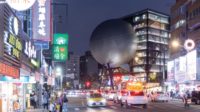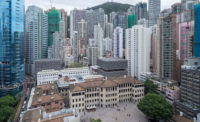At Herzog & de Meuron's Powerhouse Arts, Nostalgia for a Lost Industrial Past
Brooklyn, New York

As an architectural solution to the problem of how to turn a disused power station along Brooklyn’s Gowanus Canal into a set of art-fabrication studios, Powerhouse Arts is an impressive feat. Designed by Herzog & de Meuron with New York–based PBDW Architects, the 170,000-square-foot complex ties together the existing century-old Romanesque building’s vast and formerly decrepit turbine hall, which has been divided vertically into two floors topped by a double-height “grand hall,” with a new six-story structure built atop the adjacent foundations of the station’s long-ago-demolished boiler house.

1

2
Powerhouse Arts sits on Brooklyn’s Gowanus Canal (1 and top of page). Extraction equipment is visible by the entrance (2). Photos © Iwan Baan (1) and Albert Vecerka/Esto (2), click to enlarge.
In the manner one might expect of Herzog & de Meuron—the same firm that famously transformed London’s Bankside Power Station into the Tate Modern—much attention has been paid to the sequence of spaces that carries staff and visitors into and through the building. An inconspicuous entrance cut into the turbine hall’s east elevation draws you through a compressed, wood-clad vestibule and into a lobby backed by a monolithic expanse of concrete: immediately, the extent to which the building has been remade becomes clear. Above a reception desk along the concrete wall, a narrow steel stair rises upward past the second floor to the third, where through a small opening some 75 feet in the air, a slice of blue sky is visible, framed by a set of red roof trusses.

3

4
The turbine hall underwent an extensive process of disassembly, remediation, and reconstruction (3). Its upper level was ultimately turned into a sweeping “grand hall” (4). Photos © Albert Vecerka/Esto (3), Iwan Baan (4)

A stair rises above the lobby. Photo © Iwan Baan
From the lobby, you can either proceed up the vertiginous stair to the grand hall or pass into the new structure, where a long corridor provides access to elevators and stairs leading to the various studios. The grand hall, with its monumental row of windows, clerestories, and hefty trusses, holds the memory of the turbines that once powered Brooklyn’s subways; notched into its graffiti-covered brick walls are dozens of chases in which heavy-duty wiring once ran. At nearly 20,000 square feet, the hall will be useful for events and for staging large-scale artworks, and it makes for a fitting culmination to Herzog & de Meuron’s promenade architecturale. But it is the studios in which the architects seem, justifiably, to take the most pride. These include an airy ceramics studio, a two-level print shop, and a multidisciplinary studio dedicated to the creation of public art, plus shops for textiles and wood, and two for metal (one large and one small) that have not yet been completed. Most are filled with northern light, and each is, or will be, outfitted with all manner of fabrication equipment.

5

6
The ceramics shop gets extensive northern light (5), and the print shop (6) overlooks a double-height event space (7). Photos © Iwan Baan (5 & 6), Albert Vecerka/Esto (7)

7
Where necessary, particularly in the ceramics and wood shops, advanced extraction systems have been installed to remove contaminants from the air. These and other mechanical systems required to support the studios—from compressed air to inflated fabric HVAC diffusers (“ductsox”) that prevent air gusts—demanded tight coordination between the design team and subcontractors. The intertwined network of pipes, ducts, and conduits exposed overhead has a beauty befitting this complex choreography; the systems, as PBDW associate Tory Cuddy puts it, have been “elevated to an artistic level.”
Within the studios, flexibility rules: apart from a regular grid of columns and the new structure’s core, little or nothing is permanently fixed. The building is “a piece of infrastructure that can be used in many different ways,” says Herzog & de Meuron partner Ascan Mergenthaler, who led the project from Basel in concert with New York–based associate Philip Schmerbeck, and it is to the firm’s credit that the claim feels eminently true. The only obvious flourish within the new building is its interior glazing, framed in galvanized steel, which turns even a walk to the bathroom into an opportunity to observe art in the making. Outside, the pragmatic approach continues. Herzog & de Meuron’s pink cast-in-place concrete facade, into which arched windows recalling those of the demolished boiler house are punched, betrays no sense of excess (though its execution, with two thermally separated layers and aggregate matching the adjacent brick, is impressive). Behind a sizable parking and loading area at the back of the building is a matter-of-fact strip of landscaping along the canal frontage. The work of Ken Smith Workshop, this landscape helps protect the site from flooding and keeps space open for a future public walkway.
It’s clear enough that Powerhouse is a place where art will be made. How it will operate, however, has not yet been fully decided. The philanthropist Joshua Rechnitz founded Powerhouse Arts in 2015 as part of his plan to repurpose the power station, and, though it began some operations off-site before the project was completed, the organization is only now figuring out how to become self-sustaining. Rechnitz, who has reportedly given $180 million to the effort, initially sought to turn the building into artist studios but later decided instead to pursue the aim of offering the advanced fabrication capabilities required for complex artworks. Powerhouse, that is to say, is no community art space; the building is not even open to the public except during select events.
In the ceramics studio, artists who meet certain requirements can purchase memberships that provide facility access, but, as of yet, no such programs exist in the other shops. They operate instead on a fee-for-service model, where artists work with Powerhouse staff—artists in their own right—to fabricate works on their behalf. In addition, the larger of the two metal shops will be leased out to a for-profit metal fabricator, Workspace11, which fabricated the framing for the interior windows.
Powerhouse Arts director Eric Shiner, who previously led the Andy Warhol Foundation, says that the “whole reason we exist is so that artists can stay in New York,” and toward this aim the organization has tracked down more than 400 artists in Gowanus that Shiner hopes to work with. This seems like a good place to start, but much will depend on Powerhouse’s effect on the broader fabrication market. Within New York, there already exists a network of small-scale fabricators, not all of which will be able to partner with Powerhouse in the manner of Workspace11. If Shiner is serious about the proposition of keeping art fabrication in New York, he will need to be aware of the fact that Powerhouse could represent tough competition for these firms, and be open to adjusting its business model accordingly.
And what will the opening of this new building and business mean for Gowanus? Shiner suggests that Powerhouse will help keep the neighborhood’s manufacturing legacy alive even as costly residential towers rise all around the canal, and much of the rhetoric employed by backers of the project has emphasized this point. But Powerhouse’s notion of “industrial” is of the chic, curated variety, and as such represents change rather than continuity for the area. Consider the graffiti that adorns the interiors of the turbine hall, a relic of decades of abandonment. Mindful of the pitfalls of erasing this history on the one hand and of fetishizing it on the other, Powerhouse’s leaders have thoughtfully opted to leave much of the graffiti intact, erase parts of it when necessary, and even to commission select artists to add to it. Nonetheless, the very fact that Powerhouse leaders now speak of “commissioning” graffiti, and that the graffiti is seen in a “grand hall,” illustrates that the change undergone by the building, and by the neighborhood, is irrevocable—though not necessarily unwelcome. Powerhouse has created well-paying jobs, and has, at no small cost, returned a badly polluted site to productive use.

Gowanus, the neighborhood around Powerhouse Arts, is rapidly changing. Photo © Iwan Baan
In a speech at Powerhouse’s opening, Rechnitz derided what he referred to as the “art fair industrial complex.” But Powerhouse itself aims to become a place where the kind of work on display at art fairs, and even in museums, is fabricated. Similarly, no matter how hard it strives to keep manufacturing in Gowanus, Powerhouse is a marker of the wealth arriving in the neighborhood; its attempts to position itself as heir to an industrial legacy succeed only in highlighting the impossible divide that separates this moneyed cultural institution from the factories and chemical plants that once operated alongside the canal. Herzog & de Meuron’s stark pink facades give this contradiction poetic built form. Even as the new building matches the color, scale, and round arches of the existing turbine hall, the monumental blankness of its exterior betrays an acute awareness that the industrial ethos represented by the turbine hall has been reduced to an aesthetic. In the gap that separates the new from the old is nostalgia for a vanishing way of life, and a sober acknowledgment that the past can be referenced, and gestured to, but not relived.
Click plans to enlarge

Click section to enlarge

Credits
Architect:
Herzog & de Meuron — Ascan Mergenthaler, partner in charge; Philip Schmerbeck, associate and project director; Jack Brough, project manager, Sam Zeif, project architect
Executive/Preservation Architect:
PBDW Architects — James Seger, partner in charge; Tory Cuddy, associate and project manager; Catherine Zagalis, project architect
Engineers:
Buro Happold (m/e/p); Silman (structural)
Consultants:
Ken Smith Workshop (landscape); Tillotson Design Associates (lighting); Roux (environmental); Eckersley O’Callaghan (facade); ICR-ICC, Eugene Architecture (masonry conservation)
General Contractor:
Urban Atelier Group
Owner:
Powerhouse Arts
Size:
170,000 square feet
Cost:
$180 million (total)
Completion Date:
May 2023
Sources
Exterior Cladding:
The Belden Brick Company, Glen-Gery (masonry); StructureTech New York, U.S. Concrete (cast-in-place concrete)
Roofing:
EPIC Metals (acoustic roof deck); Siplast (built-up roofing)
Windows & Skylights:
PICHLER Projects
Interior Finishes:
Sherwin-Williams (paints and stains); Armstrong (acoustical ceilings); PGS Millwork (cabinetry, woodwork); Workspace11 (paneling)
Lighting:
B-K Lighting (exterior); Louis Poulsen (exterior catenary)
Plumbing:
Bradley, Haws (emergency eyewash and shower); T&S Brass and Bronze Works, Elkay (faucets)
Energy Management:
Delta Controls
Hardware:
Schlage (locksets, pulls); Falcon (closers); Von Duprin (exit devices)




